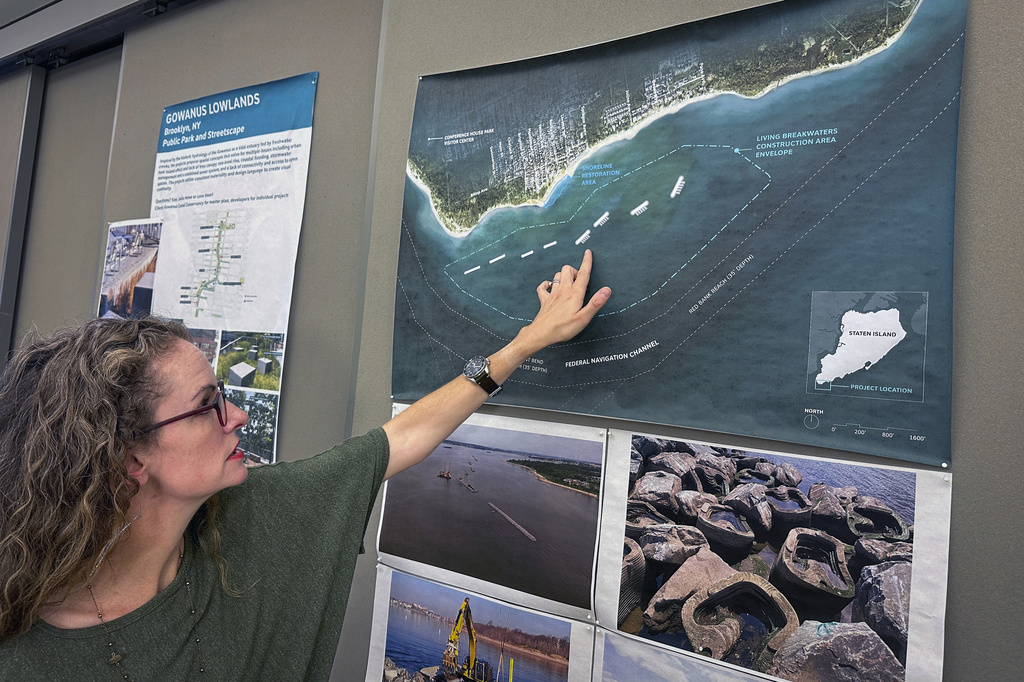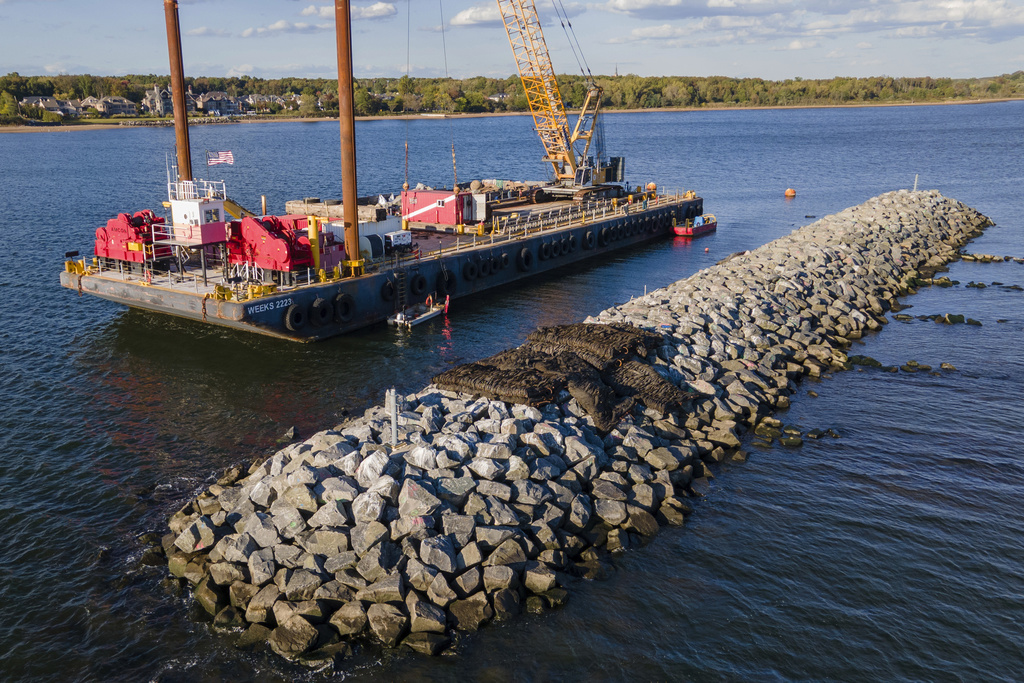Living Breakwaters Shield Staten Island’s Coast from Storms \ Newslooks \ Washington DC \ Mary Sidiqi \ Evening Edition \ Staten Island’s Tottenville neighborhood, devastated by Superstorm Sandy, now has an artificial reef system called “Living Breakwaters” aimed at reducing storm impacts and reviving local marine life. Funded with $111 million, these concrete-and-rock barriers lie 1,000 feet offshore and are designed to lessen wave force and erosion while supporting oyster beds and other marine habitats.

New Staten Island Breakwaters: Quick Looks
- Purpose and Funding: Built with $111 million in Sandy recovery funds, the “Living Breakwaters” project aims to reduce storm damage and erosion along Tottenville’s coast.
- Storm Protection: While they can’t prevent flooding, these reefs reduce wave strength and provide storm protection to the coastline.
- Environmental Benefits: The breakwaters support marine life, providing refuge for oysters, crabs, and fish, which benefit from tidepools and textured concrete surfaces.
- Impact on Local Wildlife: Birds, seals, and fish are already using the reefs, and the Billion Oyster Project plans to introduce oyster beds soon.
- Model for Coastal Cities: Similar projects are underway in coastal areas like California, Florida, and Washington, inspired by Tottenville’s ecosystem-friendly approach.
Deep Look
When Sandy hit in 2012, Tottenville’s minimal natural defenses, including a narrow strip of sand and sparse vegetation, did little to protect against the storm’s surge. Homes were torn from foundations, and tragically, some lives were lost. Today, however, the “Living Breakwaters” are poised to soften the impact of future storms. Although these structures cannot prevent flooding, their concrete and rock formation weakens wave force, lessening erosion and reducing potential damage to the coastline. This design aims to offer Tottenville residents a greater sense of security without obstructing access to the beach, unlike traditional seawalls.
Architect Pippa Brashear of SCAPE Landscape Architecture, who led the project, explained that the breakwaters integrate “living” elements designed to support marine life. In addition to absorbing wave energy, the reefs feature tidepools and textured surfaces that attract and shelter fish, crabs, oysters, and other sea life. This eco-conscious approach contrasts with many traditional coastal barriers, which often repel sea life with their smooth concrete surfaces.
“Tottenville residents wanted a solution that didn’t cut them off from the beach,” Brashear explained. “The breakwaters are more than a storm defense—they’re a vibrant ecosystem that can grow and thrive.”
Environmental Benefits and Marine Life Attraction
Beyond storm resilience, the Living Breakwaters aim to revive marine habitats that suffered decades of damage from overfishing, pollution, and dredging. Algae has already begun to coat the reefs’ textured concrete surfaces, and tidepools formed in the structure offer refuge to snails, barnacles, shrimp, and other organisms. Migrating birds and wintering seals have also been seen using the reefs, underscoring their positive environmental impact. As part of the project, The Billion Oyster Project plans to restore native oyster populations, historically known for filtering water pollutants and reducing wave energy. Before overharvesting, oyster beds in Raritan Bay played a significant role in protecting the coastline during storms, and project leaders hope to replicate this effect.
Coastal Protection in Other Cities
Staten Island’s approach is inspiring similar projects in other vulnerable areas. In San Diego, for example, shoreline habitats are being outfitted with tidepools similar to those in Tottenville, supporting local algae and animal populations. Luke Miller, a marine biologist at San Diego State University, emphasized that these pools provide critical habitats for marine life, especially as tide levels shift. “When the tide is out, the pools are teeming with life—algae, animals, each relying on that microhabitat,” Miller explained.
In Seattle, an elaborate $400 million seawall featuring “living” elements has lined a section of the city’s coastline since 2017, designed specifically to improve habitat conditions for juvenile salmon. This success in Seattle has encouraged additional shoreline protection projects across the Pacific coast, with California and Washington taking a closer look at eco-conscious designs that combine storm protection with habitat support.
New York’s Growing Coastal Defense Network
The Living Breakwaters are part of a larger network of coastal defense projects initiated across New York City since Superstorm Sandy. Manhattan, for instance, is elevating parkland along the East River to create a barrier against storm surges. This stretch will eventually connect to floodwalls and additional infrastructure forming a “U” around Manhattan’s southern edge. On the Rockaway Peninsula, boardwalks destroyed by Sandy have been rebuilt with fortified flood barriers, adding another layer of protection for Queens’ residents.
Despite these efforts, experts caution that breakwaters alone may not be enough in the face of rising sea levels. Larissa Naylor, a professor of geomorphology and environmental geography at the University of Glasgow, notes that while these defenses are beneficial, they’re a temporary solution. “They’re buying some time,” she said, underscoring the importance of broader climate adaptation measures.
Community Response and Ecological Changes
Neighborhood resident Michele Heerlein, who has witnessed increased marine life since the breakwaters were installed, remains cautiously optimistic. “If another storm comes, it’s not doing nothing,” Heerlein said, pointing to the visible increase in stingrays, fish, and even small sharks along the beach. “They might bring the clams and the mussels back,” she added, referencing the region’s once-thriving shellfish population.
The Living Breakwaters project has become a model for coastal protection, blending engineering and ecological awareness to help protect vulnerable shorelines. For Staten Island’s residents, the breakwaters offer both a tangible defense against the sea and a potential restoration of the rich marine habitats that once flourished in Raritan Bay.







